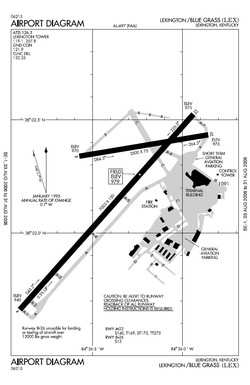Sat, Nov 25, 2006
Controllers Warn Saratoga Before Takeoff On Wrong Runway
 The FAA says another
aircraft nearly departed the wrong runway at Lexington's Blue Grass
Airport on November 9.
The FAA says another
aircraft nearly departed the wrong runway at Lexington's Blue Grass
Airport on November 9.
In an eerie repeat of the Comair Flight 5191 tragedy, a Piper
Saratoga cleared for takeoff on the airport's longer runway 22
lined up instead on runway 26. One of the two tower controllers on
duty alerted the pilot, who then taxied to the correct runway
and made a safe departure.
The controller handling the flight filed a report using NASA's
Aviation Safety Reporting System (ASRS). ASRS is a safety
improvement program allowing those involved to anonymously report
incidents without fear of FAA enforcement action.
A copy of that report was subsequently released by the National
Air Traffic Controllers Association (NATCA). A NATCA spokesman says
the incident highlights the value of having two controllers on
duty.
Earlier this summer Comair Flight 5191 attempted to depart
runway 26 after cleared for departure on 22. That attempt ended in
disaster as the regional jet crashed off the departure end the
runway killing 49 of the 50 people aboard. There was only one
controller on duty the morning of that accident.
FAA rules at the time required more than one duty controller,
but staffing shortages at Blue Grass led management to ignore that
mandate for overnight hours when traffic was typically light. NATCA
made much of the fact in the media following the accident
suggesting had two controllers been on duty it might not have
occurred.
Runway 26 was closed at the time of the Comair accident which
happened before dawn on August 27. There were several taxiway and
runway construction projects underway that may have led to the
crew's confusion. Construction on runway 26 has since been
completed and that runway is operational.
An FAA spokesperson told the Louisville Courier-Journal the
agency won't formally investigate, but it would like to understand
the incident. The NTSB says it will look into the situation as part
of its larger Flight 5191 investigation.
The airport's managers say the FAA recently inspected its runway
and taxiway signage and markings finding them all in compliance
with federal standards.
More News
Also: ALPA Warns, Aviation Meteorology Reference, Jennifer Homendy Re-Ups, CAF Tampa Bay The court has approved Van's Aircraft's bankruptcy reorganization plans, settling a stressf>[...]
Also: ALPA Warns, Aviation Meteorology Reference, Jennifer Homendy Re-Ups, CAF Tampa Bay The court has approved Van's Aircraft's bankruptcy reorganization plans, settling a stressf>[...]
Flameout Pattern An approach normally conducted by a single-engine military aircraft experiencing loss or anticipating loss of engine power or control. The standard overhead approa>[...]
Aero Linx: VC-25 - Air Force One The mission of the VC-25 aircraft — Air Force One — is to provide air transport for the president of the United States. The presidentia>[...]
We're Everywhere... Thanks To You! Even with the vast resources and incredibly far-reaching scope of the Aero-News Network, every now and then a story that should be reported on sl>[...]
 Airborne 05.20.24: Van's BK Exit, Bud Anderson, Air Race Classic
Airborne 05.20.24: Van's BK Exit, Bud Anderson, Air Race Classic Airborne 05.20.24: Van's BK Exit, Bud Anderson, Air Race Classic
Airborne 05.20.24: Van's BK Exit, Bud Anderson, Air Race Classic ANN's Daily Aero-Term (05.18.24): Flameout Pattern
ANN's Daily Aero-Term (05.18.24): Flameout Pattern ANN's Daily Aero-Linx (05.18.24)
ANN's Daily Aero-Linx (05.18.24) ANN FAQ: How Do I Become A News Spy?
ANN FAQ: How Do I Become A News Spy?



